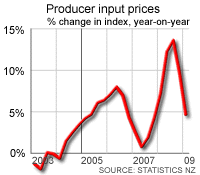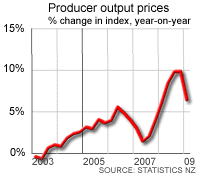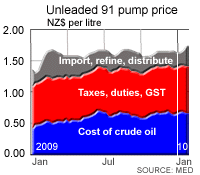 A near doubling of wholesale electricity prices was the major factor driving inflation in the costs of inputs for businesses to 11.8% in the June quarter from a year ago. (Updated below to include comments from JP Morgan's Helen Kevans and ANZ National's Khoon Goh)
This was the highest level since September 1985 and input inflation between the March and June quarters of 5.6% was the highest since the March 1980 quarter. This 5.6% quarterly inflation was more than double the market's forecasts for inflation of around 2.6%.
Business outputs inflation in the June quarter from the March quarter was 3.5%, which was again more than twice economist expectations. Business output inflation for the June quarter from a year ago rose to 8.5% from 6.1% in the June quarter.
The quarterly outputs inflation was the highest since the June quarter of 1985 and the annual inflation was the highest since the September quarter of 1987.
A near doubling of wholesale electricity prices was the major factor driving inflation in the costs of inputs for businesses to 11.8% in the June quarter from a year ago. (Updated below to include comments from JP Morgan's Helen Kevans and ANZ National's Khoon Goh)
This was the highest level since September 1985 and input inflation between the March and June quarters of 5.6% was the highest since the March 1980 quarter. This 5.6% quarterly inflation was more than double the market's forecasts for inflation of around 2.6%.
Business outputs inflation in the June quarter from the March quarter was 3.5%, which was again more than twice economist expectations. Business output inflation for the June quarter from a year ago rose to 8.5% from 6.1% in the June quarter.
The quarterly outputs inflation was the highest since the June quarter of 1985 and the annual inflation was the highest since the September quarter of 1987.
 These figures will shock economists and may cause some to reassess their views on whether the Reserve Bank can continue to cut the Official Cash Rate through the rest of the year. Before these numbers, most saw the Reserve Bank cutting the OCR three times by 25 basis points each time to take the OCR to 7.25% by the end of the year.
This, in theory, would have been passed on to both mortgage borrowers and term deposit investors.
The leap in wholesale electricity prices because of the now-ended drought was a major factor, as was the jump in the oil price.
But the sheer scale of the rise in inflationary pressures facing businesses will surprise many. June quarter consumer price inflation was 4% from a year ago and was 1.6% for the quarter, data showed last month. September quarter inflation is due to be 5% or higher.
These figures will shock economists and may cause some to reassess their views on whether the Reserve Bank can continue to cut the Official Cash Rate through the rest of the year. Before these numbers, most saw the Reserve Bank cutting the OCR three times by 25 basis points each time to take the OCR to 7.25% by the end of the year.
This, in theory, would have been passed on to both mortgage borrowers and term deposit investors.
The leap in wholesale electricity prices because of the now-ended drought was a major factor, as was the jump in the oil price.
But the sheer scale of the rise in inflationary pressures facing businesses will surprise many. June quarter consumer price inflation was 4% from a year ago and was 1.6% for the quarter, data showed last month. September quarter inflation is due to be 5% or higher.

 But the fall in the currency in recent weeks means most of that fall in the crude oil price is unlikely to be passed on with lower prices at the pumps.
Can the Reserve Bank afford to ignore this spike in producer prices?
How can it credibly cut interest rates when producer price inflation is running at levels not seen in over 20 years? Can it credibly look through this inflation shock?.
Helen Kevans at JP Morgan had this to say about the figures.
But the fall in the currency in recent weeks means most of that fall in the crude oil price is unlikely to be passed on with lower prices at the pumps.
Can the Reserve Bank afford to ignore this spike in producer prices?
How can it credibly cut interest rates when producer price inflation is running at levels not seen in over 20 years? Can it credibly look through this inflation shock?.
Helen Kevans at JP Morgan had this to say about the figures.
Pipeline price pressures continue to build in New Zealand. Producer input prices surged 5.6%q/q in 2Q, more than double the 2.3%q/q spike recorded in the March quarter and the largest rise since 1980. Output prices also grew at a much faster rate than expected, rising 3.5%q/q, the largest rise since 1985, and up from a 1.8% rise previously. Not only are pipeline pressures clearly building, but the significantly faster rate of growth in input prices over output prices confirms that producers are finding it difficult to pass rising costs on to consumers, leaving profit margins squeezed. This is of little surprise given the sharp slowdown in domestic demand in recent months, which has diminished pricing power. On monetary policy, with significant price pressures in the pipeline, there is the risk that RBNZ officials may start to rethink the length and depth of the easing cycle on which it recently embarked. The RBNZ expects that inflation will peak at 5% in 3Q, but with producer price rises remaining significant, headline CPI is more likely to peak in early 2009 and hold well-above the RBNZ's 1-3% target band for an extended period. Our forecast calls for 25bp rate cuts in September, October, and December, and further rate cuts in 2009, taking the key rate 6.25% by mid-2009. Upside surprises in the upcoming CPI data could, however, slow the pace of monetary easing.Here's what ANZ's senior markets economist Khoon Goh had to say.
It is easy to dismiss the PPI numbers as being inflated by electricity and oil prices, both of which has fallen since, which can be expected to result in a partial unwinding in the September quarter. However, even excluding the electricity generation and wholesale industries, we estimated that input prices were still up strongly at 3.3 percent in the quarter, and output prices by around 2.0 percent. Still a hint of an undercurrent of pipeline inflation pressure in the system which will continue to keep the RBNZ wary. Though there are limited monetary policy implications from today's data, it is a timely reminder that lingering inflation pressures remain. Growth may be slowing rapidly, but we are still getting upside inflation surprises. This is partly due to lags "“ it takes time for weak growth to ease inflation pressure. Nonetheless, it does highlight that the RBNZ is running a risk in starting the easing cycle early. This reinforces our view of a staggered easing cycle, where the RBNZ cuts rates for the rest of this year, pauses to reassess the growth and inflation outlook, before resuming the easing cycle from mid-2009. A more aggressive easing cycle is still ultimately predicated on the global picture and the outlook for commodity prices in particular

We welcome your comments below. If you are not already registered, please register to comment.
Remember we welcome robust, respectful and insightful debate. We don't welcome abusive or defamatory comments and will de-register those repeatedly making such comments. Our current comment policy is here.